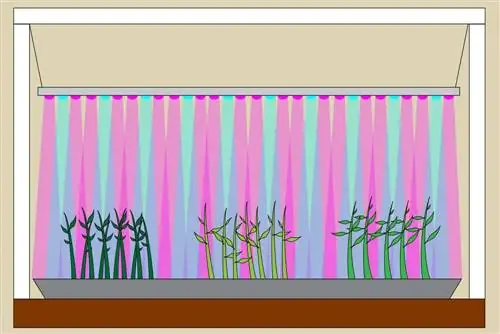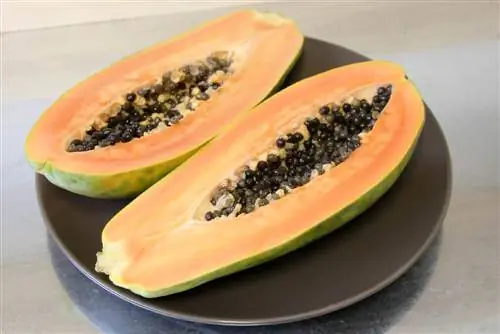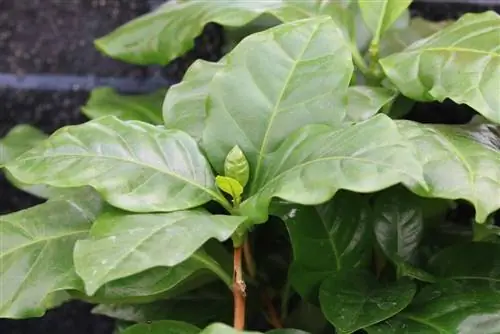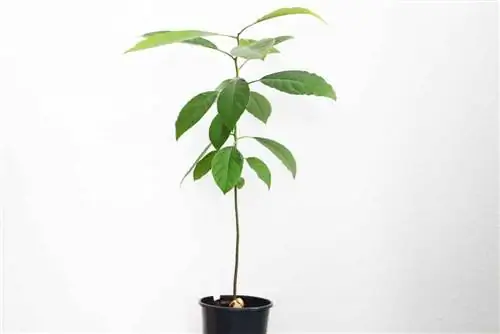- Author admin [email protected].
- Public 2023-12-17 03:39.
- Last modified 2025-01-24 12:45.
Star anise Illicium verum, also known as Chinese star anise, is the only edible species. In contrast, Japanese star anise (Illicium anisatum), whose fruits are very similar to the real one, is extremely poisonous. In its homeland, star anise grows as a small, evergreen tree. In our latitudes it is relatively rare. You can especially admire it in botanical gardens. Despite everything, it is possible to keep it as a houseplant. It can be left outside in summer, but must be kept frost-free over the winter.
Location and substrate requirements
Since this plant requires sufficient light, it should be placed in a bright or sunny to partially shaded location, ideally in a winter garden or heated greenhouse. Any other bright and warm room is also suitable. Direct sunlight should be avoided and the room temperature should ideally be between 17 and 20 degrees. From May, after the so-called Ice Saints, the plant can be placed outside.
The respective planter should have sufficient drainage holes and good drainage, for example made of coarse gravel. Nutrient-rich garden soil, a humus-rich, composted substrate, normal standard soil or soil mixed with sand and peat can be used as a substrate. The soil should be permeable and fresh to moist.
Tip:
If the star anise moves outside in May, you should put it in a shady place for the first few days so that it can slowly get used to the new environmental conditions. Later it can be moved to a brighter location.
Optimal care of star anise
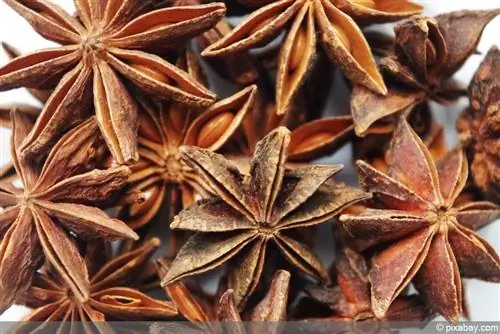
Illicium verum should be watered so that the substrate is always evenly moist but not too wet. Watering should be regular, especially in summer. It is best to let the top layer of substrate dry before each watering. Since star anise requires high humidity, it should be sprayed regularly with lime-free water, especially if it is kept indoors all year round. Star anise can be fertilized every two weeks from June to August. If the pot is well rooted, you should repot it in fresh soil and, if necessary, a larger planter. It takes about 15 years for this houseplant to bear fruit for the first time. It can also happen that a plant does not produce any fruit at all. Once it has reached a height of approx. 40-50 cm, it should be cut back by around a third. You can achieve a bushier growth if you only cut off the tips of the shoots.
Winter properly
- Star anise is not hardy enough.
- It can withstand temperatures up to a maximum of -12 degrees.
- For this reason, it is advisable to bring it into winter quarters before the first frosts.
- Wintering should not be too warm.
- The temperatures should not rise above 18 degrees or fall below 15 degrees.
- Star anise needs to be watered every now and then even during the cold season.
- However, watering needs to be reduced significantly.
- The substrate should neither dry out completely nor be permanently too wet.
- Dry heating air in winter can quickly lead to an infestation with spider mites or scale insects.
- To prevent this, optimal humidity should be ensured.
- You can do this by occasionally spraying the plants with lukewarm water.
- If possible, you should use rainwater for this.
- Fertilization can be completely avoided in winter.
Propagation
Before you buy plants, you can also try propagating star anise and there are two possible ways to do this:
Through seeds
In spring, small magnolia-like, greenish-white flowers appear, from which the typical fruits of star anise, so-called follicles, develop. The eight-pointed, capsule-like fruits contain the shiny, brown seeds, with each of these eight points containing one seed. These seeds can be sown all year round. If you were lucky enough to get fresh seeds, they must first be subjected to cold treatment (stratification). To do this, place them in a foil bag with moist sand, which you then close and store in the refrigerator or, if available, in a cold store at temperatures of around 5 degrees for 1-2 months. In other closed containers, the seeds may become moldy.
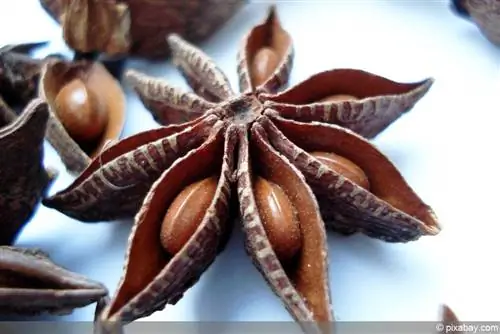
After this time, the seeds are placed about 1 cm deep in a nutrient-poor growing substrate. For example, coconut humus or commercially available potting soil, which is mixed with perlite or sand, are suitable for this. To ensure constant humidity, cover the cultivation container with glass or translucent film. Both should be removed from time to time and the substrate should be ventilated. Then place the whole thing in a bright, not full-sunny place at temperatures between 22 and 25 degrees until germination. Once small seedlings have formed with the first small leaves, they can be planted singly or individually in pots.
Tip:
Seeds from purchased fruits that are sold exclusively for decorative purposes are generally not germinable and are therefore not suitable for cultivation. With a lot of luck you can get the right seeds or young plants in specialist nurseries.
Through cuttings
Cuttings for propagation can be obtained by cutting back existing plants. Well-ripened but not woody shoot tips are used. Each cutting should be around 15-20 cm long and have 2-3 pairs of leaves. Larger leaves are cut in half to minimize evaporation. The cuttings are then placed in small pots in a permeable and nutrient-poor substrate and a film is placed over them.
Here, too, it is advisable to mix sand or perlite into the growing substrate. At soil temperatures between 20 and 25 degrees, rooting usually takes place after about 3-4 weeks. If roots have formed on the cutting, this will be reflected in the first shoots. If this is the case, the film can be removed and the young plants can continue to be cultivated. Once the pots are well rooted, they are transplanted into larger pots. If the plants are large enough, you can trim the shoot tips to achieve better branching.
Pests
The most common pests to be expected are:
Spider mites
Spider mites often appear during overwintering due to low humidity. They can be recognized by the fine white webs on the leaf axils. A thorough shower is often enough to combat it. The undersides of the leaves should not be forgotten either. The plant should then be treated with suitable sprays. As a rule, you have to spray several times at certain intervals.
Scale insects
A scale insect infestation can be recognized by small brown shields that are mainly located on the trunk and branches or shoots. Systemic remedies from specialist retailers can be used to combat this. Commercially available plant protection sticks are usually not sufficiently effective because they also contain fertilizer and the poison concentration is often too low.
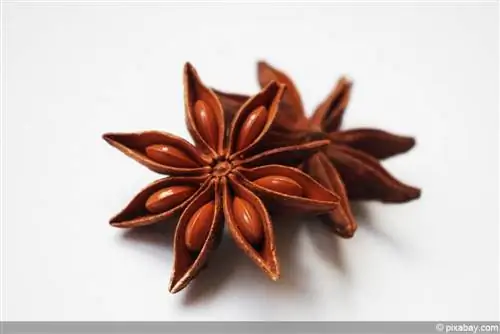
Tip:
To prevent pest infestation, you should always ensure there is sufficient humidity, for example by regularly spraying the plants with water. When using spray agents, you should strictly follow the instructions of the respective manufacturer.
Conclusion
If you want to grow star anise yourself, you should take into account that in this country it is only cultivated in pots, i.e. as a houseplant. It can be left outdoors from spring to autumn. However, it should move to winter quarters before the first frost. However, it can take a few years for the plants to produce fruit for the first time.


